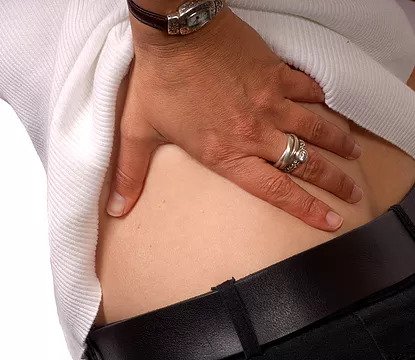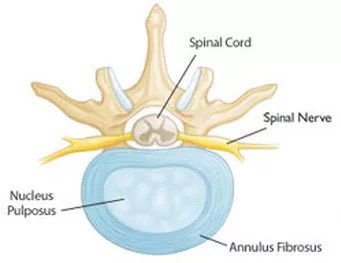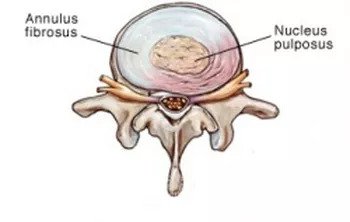BULGING SPINAL DISC

Hearing you have a slipped or bulged disc can be a terrifying thing. Many people come across the diagnosis after reading their own xray, CT or MRI reports and begin to panic. But a bulged disc doesnt need to be a disaster if you know how to manage it.
What is a Disc?
Spinal discs are the shock absorbers of our spine, laying between each vertebra. Discs are made up of a gel substance, called the nucleus pulposus, surrounded by rings of strong cartillage, called the annulus fibrosis. The nucleus is responsible for the majority of the shock absorption, while the annulus’ job is to support the nucleus by forming a wall around it to keep it in place.
How does a Disc Bulge?
The nucleus is like jelly or a gooey caramel. Under normal circumstances it moves around inside the annulus in response to the forces placed on the spine. If the annulus becomes weakened or damaged it allows the nucleus to push out into the weakened supportive wall causing the disc to become bulged in appearance.
Right: The disc is made up of the gel like nucleus pulposus and the cartilage rings of the annulus fibrosis
Far right: A disc bulges when the walls made by the annulus become weakened allowing the nucleus to push out and budge the disc


The annulus of the disc can become weakened from a variety of causes, which can be summarised into two main categories: Wear and tear, causing a gradual weakening of the wall of the disc or an acute injury which causes sudden pressure on the annulus and causes some of the rings to tear.
Wear and Tear
This is by far the most common cause of disc bulges. Wear and tear occurs in the majority of cases due to poor posture due to muscles imbalances (muscles weakness combined with muscle tightness) for example poor core and gluteal strength combined with tight hamstrings.
Your spine performs best with a slight S-Shape curve when looked at from the side. Postures that increase or decrease these curves can both contribute to causing the nucleus to continually press against the walls on one side of the disc. Prolonged maintenance of these positions cause the annulus to weaken and allows the disc to bulge.
Acute Injury
A sudden excessive forces placed on the spine such as those experienced in a fall, football tackle or motor vehicle accident can also cause trauma to spinal discs.
While spinal discs are built to absorb shock they have a limit to the amount of force they can withstand. When this limit is exceeded the cartilage of the annulus may tear.
Acute injuries of the disc are not limited to occasions with high speed involved. Lifting with incorrect posture, or lifting objects that are too heavy can also cause acute disc injury.
Genetics can also play a part in disc injuries. Certain inherited postures and muscle imbalances as well as the make-up of the discs themselves can contribute.
How do I Know if I Have a Disc Bulge?
The symptoms of a disc bulge can be rapid or gradual in onset, usually corresponding to the way that the disc bulge occured. Interestingly, the severity of symptoms, however, does not necessarily correspond to the severity of the bulge. A person who has a small wear and tear type of disc bulge may experience severe pain due to an exacerbation after moving house, whereas another person with a large bulge from a car accident may continue to work and perform exercise with minimal symptoms.
Common symptoms include:
- Back pain
- Symptoms in the legs such as pain in the leg or sciatica, pins and needles, numbness and or weakness of the muscles of the legs or feet.
- Altered bladder or bowel function such as difficulty initiating or difficulty holding bladder or bowel motions and/or pins and needles or numbness in the genital area can indicate a more severe injury. If you experience these symptoms you should seek urgent advice from a medical professional.
People with disc injuries generally decribe a worsening of their symptoms:
- When sitting or standing after prolonged sitting
- When bending orward
- With a cough or sneeze
- When lifting
Do I Need a Scan such as an X-Ray or MRI?
While scans provide a picture of your spine they are not necessary in the majority of disc bulges. MRI and CT scans are the only scans that will actually show a bulged disc. X-rays can show changes around the spine that we know are associated with disc bulges such as a narrowing of the gap between the vertebrae.
Your Physiotherapist or GP is able to perform a series of clinical tests to determine the likelihood of a bulged disc and whether or not you have any signs of nerve compression.
Effective conservative treatment can generally be provided to most disc bulge injuries without requiring surgery. Scans whilst helpful to visualise the injury provide little guidance to this conservative treatment.
How is a Disc Bulge Managed?
In the vast majority of cases disc bulges can be effectively managed with conservative treatment.
Immediate Management
As with the immediate treatment of any soft tissue injury consists of the RICER protocol:
Rest,
Ice,
Compression,
Elevation, and
Referral
Obviously in the case of a disc injury rest, ice and referral are the most important. Some people may also feel that heating the surrounding muscles of the back which often go into spasm and cause the most pain, with a wheat pack is helpful for managing symptoms.
The rest should be relative, for example resting from sport, exercise and lifting, however bedrest is not advised and may actually make your symptoms worse. Gentle movement in positions where the spine is not excessively bent forward or backward or twisted can help to minimise symptoms. Short walks are also advised.
Your pharmacist or GP can also advise whether you would benefit from taking medications or manage pain, inflammation or nerve symptoms.
A Physiotherapist should be seen as soon as possible after the injury to determine the extent of injury and to advise on treatment and rehabilitation.
Managing after the acute period
After the symptoms from an acute injury or exacerbation have settled your Physiotherapist will provide treatment and prescribe exercises to assist with restoring normal spinal movement, improving core stability and rectifying any muscle imbalances. The overall aim is to ensure you maintain optimal spinal posture to reduce unneccessary forces on the spinal disc and prevent recurrence of your injury.
Treatment will focus on returning you to your usual activities such as work and sport and leisure activities that you may have avoided. Depending on the demands of these activities this phase of treatment will take a varying length of time. As a general guide discs, like other soft tissues including cartilage and ligaments remain weakened for at least 6weeks after injury.
What is My Prognosis?
Even though a bulged disc sounds disasterous, the prognosis is quite good. In fact many people have budged discs as seen on scans without having experienced any symptoms and didn’t even know they were there.
While it’s not a quick fix, early effective management of a disc bulge should see you return to most if not all pre-injury activities.
Occassionally, most often with severe leg pain that does not decrease with conservative treatment (over a period of more than six months) or with bladder or bowel disfunction, surgery may be required.
